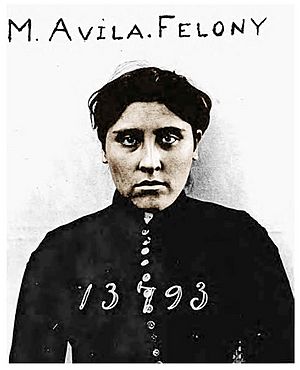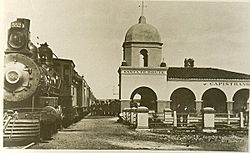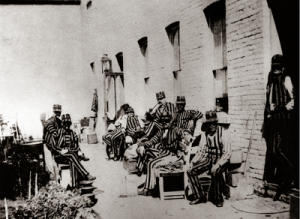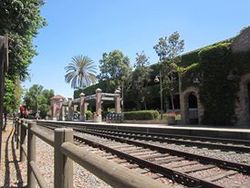Modesta Avila facts for kids
Modesta Avila (born around 1867 or 1869 – died September 1891) was a young woman from California who lived on a ranch. She is remembered for protesting against the Santa Fe Railroad. She became the first person in Orange County, California, to be sent to state prison.
In 1889, Modesta placed something on the railroad tracks to show her anger. She was upset because the Santa Fe Railroad was building tracks across her family's land without paying them fairly. She received a warning at first. However, she kept challenging the authorities. Four months later, she was arrested.
Modesta had two trials. The first jury could not agree, but in the second trial, she was found guilty. She was sentenced to three years in San Quentin State Prison. Today, many people see Modesta Avila as a hero for Latino people in the county. Some even say she is the "White Lady," a ghost seen walking along the railroad tracks since the 1930s.
Contents
Who Was Modesta Avila?
Modesta Avila was born in San Juan Capistrano, in Orange County, California, either in 1867 or 1869. We do not know much about her early life. By the time she was 20, she had inherited land from her mother. This land was just north of the Capistrano train station. Modesta raised chickens there. People described her as a "dark-eyed beauty" and a very proud woman.
At that time, people born in San Juan Capistrano who were of Mexican heritage were often treated unfairly. Modesta had been held in the Los Angeles County Jail for 30 days in 1888 for "vagrancy," which meant she was seen as having no fixed home or work.
Why Did Modesta Protest the Railroad?
Modesta was very upset when the Santa Fe Railroad built tracks through her family's land. The tracks were only 15 feet from her home. She felt she had not been paid enough for her land. The railroad also caused problems for her chickens and made her life noisy and difficult.
In 1889, she decided to protest. Some stories say she hung her laundry on a clothesline across the tracks. Other reports say she put a railroad tie (a wooden beam) across the tracks. She also placed a fence post between the rails. On this post, she attached a note that said: "This land belongs to me. And if the railroad wants to run here, they will have to pay me ten thousand dollars."
Max Mendelson, the railroad's agent, removed the post. He told Modesta that the railroad had the right to build there. He ordered her not to interfere again.
What Happened After Her Protest?
There is some confusion about what happened next. Modesta seemed to believe she would get the money. She even went to a bank in Santa Ana to ask how she could receive a $10,000 payment. She also threw a party to celebrate her expected payment.
She was arrested at the party for disturbing the peace. She annoyed the authorities by boasting in court about her "victory" over the railroad. According to historian Lisbeth Haas, it was Modesta's actions after her protest, not the protest itself, that led to her arrest four months later. She was charged with "attempted obstruction of a train." It seems she was made an example of to show that protests would be punished under the new legal system.
Modesta's Trial and Time in Prison
Modesta's first trial for interfering with the tracks took place at the new Orange County Superior Court. The first trial ended with a jury that could not agree. Before her second trial, rumors spread that Modesta was pregnant. This was considered a serious issue at the time.
Her lawyer, George Hayford, believed that her pregnancy played a big part in the decision to send her to prison for three years. He wrote that her "real crime is that she is a poor girl not having sense enough to have been married." Hayford tried to appeal the decision, saying she was "convicted on her reputation, not her deed." He lost the case on a small legal detail. Modesta's case may have also been used to show that Orange County was tough on crime, as she was the first person convicted of a serious crime in the county.
It is not known what happened to her baby if she was pregnant, as there is no mention of it in prison records. Modesta Avila was released from prison eight months early on March 3, 1892. However, one reporter stated that she died in prison from pneumonia in September 1891, at the age of 22 or 24. She had served two years and five months of her sentence. Her obituary in the Santa Ana Standard newspaper ended with the words: "Let those who are without sin throw the first stone."
Modesta Avila's Legacy
Today, Modesta Avila is an important figure in local stories. She is seen as a "folklore heroine" for Latino people in Orange County. The San Juan Capistrano Historical Society has placed a plaque in the town to remember her and her place in history.
In August 1988, for the 100th anniversary of the Santa Fe railroad, a re-enactment of her protest was performed. A local woman, Irma Camarena, played Modesta. The city manager, Steve Julian, narrated the event. He explained that Modesta "hated the train. It was noisy, dirty and a bit frightening. It kept her chickens from laying eggs, and its whistle kept her awake at night." He added that the railroad had paid very little for the land. Modesta's protest was "an act of pure frustration" to show her displeasure.
Many writers who study Latino history in the United States mention Modesta Avila. They see her as one of many Mexican-Americans who faced unfair treatment during that time. An opera about her, called Modesta Avila: An American Folk Opera, was performed in Westminster in 1986. An activist group in Los Angeles, which fights against companies that transport goods by rail, named themselves the Modesta Avila Coalition in 2005.
Modesta Avila is also thought to be the "White Lady," a ghost said to be seen in San Juan Capistrano's Los Rios Street Historic District. The ghost was first reported walking on the railway tracks in the 1930s, along the same path Modesta had walked.
See also
 In Spanish: Modesta Avila para niños
In Spanish: Modesta Avila para niños





